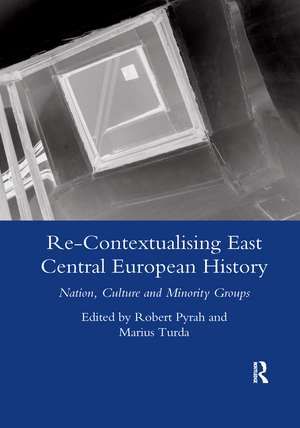Re-contextualising East Central European History: Nation, Culture and Minority Groups
Autor Robert Pyrahen Limba Engleză Paperback – 30 sep 2020
Preț: 382.95 lei
Nou
Puncte Express: 574
Preț estimativ în valută:
73.28€ • 76.36$ • 60.67£
73.28€ • 76.36$ • 60.67£
Carte tipărită la comandă
Livrare economică 03-17 aprilie
Preluare comenzi: 021 569.72.76
Specificații
ISBN-13: 9780367603106
ISBN-10: 0367603101
Pagini: 188
Dimensiuni: 174 x 246 x 13 mm
Greutate: 0.3 kg
Ediția:1
Editura: Taylor & Francis
Colecția Routledge
Locul publicării:Oxford, United Kingdom
ISBN-10: 0367603101
Pagini: 188
Dimensiuni: 174 x 246 x 13 mm
Greutate: 0.3 kg
Ediția:1
Editura: Taylor & Francis
Colecția Routledge
Locul publicării:Oxford, United Kingdom
Cuprins
Part I: Religion and Education 1. Clerical Agency and the Politics of Scriptural Translation: The 'Canonization' of the Gagauz Language in Southern Bessarabia 2. Between Loyalty, Tradition and Change: The Karlovci Gymnasium in the Kingdom of the Serbs, Croats, and Slovenes, 1917–1929 Part II: Minorities 3. More Hungarian Hungarians, More Human Humans': Social and National Discourse on Hungarian Minorities in the Interwar Period 4. Pursuing the Fascist Promise: The Transylvanian Saxon 'Self-Help' from Genesis to Empowerment, 1922–1935 5. Nationalizing the Moldavian Csangos: Clericalism and Ethnic Mobilization in World War II Romania and Hungary Part III: Language and Literature 6. Writing from Within': Jewish Romanian Writers on Jewish Life in Interwar Romania 7. Ukrainian Galicia at the Crossroads: The 'Ruthenian Alphabet War' of 1834 Part IV: Tradition and Memory 8. Folk-lingerie' and Other New Traditions: Górale Cultural Entrepreneurialism on the Margins of Poland 9. How to Tell the Story of Your Grandparents?: Ethical Dilemmas of Postmemory
Descriere
This book focuses on the developments in research, national-historical narratives, and geographies of East Central Europe. It explores the emergence of specific discursive practices, architectures of ethnic identity, and the eventual juxtaposition during the late nineteenth and twentieth centuries.
